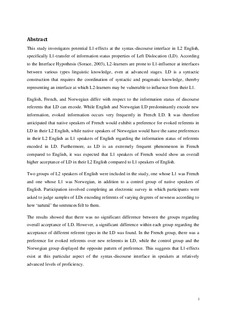Left Dislocation in L2 English. L1-effects at the syntax-discourse interface
Master thesis
Permanent lenke
http://hdl.handle.net/11250/2457682Utgivelsesdato
2017Metadata
Vis full innførselSamlinger
Sammendrag
This study investigates potential L1-effects at the syntax-discourse interface in L2 English, specifically L1-transfer of information status properties of Left Dislocation (LD). According to the Interface Hypothesis (Sorace, 2003), L2-learners are prone to L1-influence at interfaces between various types linguistic knowledge, even at advanced stages. LD is a syntactic construction that requires the coordination of syntactic and pragmatic knowledge, thereby representing an interface at which L2-learners may be vulnerable to influence from their L1.
English, French, and Norwegian differ with respect to the information status of discourse referents that LD can encode. While English and Norwegian LD predominantly encode new information, evoked information occurs very frequently in French LD. It was therefore anticipated that native speakers of French would exhibit a preference for evoked referents in LD in their L2 English, while native speakers of Norwegian would have the same preferences in their L2 English as L1 speakers of English regarding the information status of referents encoded in LD. Furthermore, as LD is an extremely frequent phenomenon in French compared to English, it was expected that L1 speakers of French would show an overall higher acceptance of LD in their L2 English compared to L1 speakers of English.
Two groups of L2 speakers of English were included in the study, one whose L1 was French and one whose L1 was Norwegian, in addition to a control group of native speakers of English. Participation involved completing an electronic survey in which participants were asked to judge samples of LDs encoding referents of varying degrees of newness according to how ‘natural’ the sentences felt to them.
The results showed that there was no significant difference between the groups regarding overall acceptance of LD. However, a significant difference within each group regarding the acceptance of different referent types in the LD was found. In the French group, there was a preference for evoked referents over new referents in LD, while the control group and the Norwegian group displayed the opposite pattern of preference. This suggests that L1-effects exist at this particular aspect of the syntax-discourse interface in speakers at relatively advanced levels of proficiency.
